



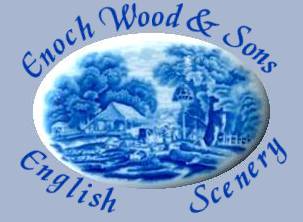
Enoch Wood's English Scenery Blue & White transferware is a tough pattern to find any information on. I know. I've been trying for about 20 years now. Yet it's not due to a lack of interest, just a lack of availability. The auctions I've been seeing over the last six months at eBay for pieces of this pattern are indicative of it's recent rediscovery and growing popularity.
Since I failed to find any information on it on the web, I decided I may as well make available what little information I have. This page is it. :)
About 20 years ago David came home from an estate sale with a collection of what looked like very old, very pretty blue and white dishes. The back of them had a mark and the Words 'Enoch Wood and Sons English Scenery', with the dates on them. Most pieces had a colorless number stamped into them as well.
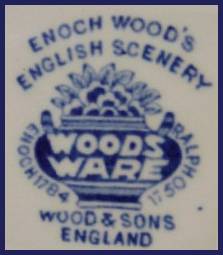
The collection he brought home included a gorgeous 14" oval platter, a smaller 12" oval platter. four oval serving bowls in two different sizes, two egg cups, a sugar bowl and a creamer, one waste bowl and numerous luncheon, salad, bread and desert size dishes as well as a dozen different small lipped round bowls of 3 different sizes. Each piece had a different 'picture' on it,
![]()

though all were of English Scenery
and had the same lovely floral border.
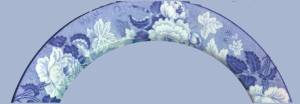
Or, I should say, almost the same border. Pieces made at different times over the many years since this pattern was first created, have changed slightly. Changed..not evolved, for I'm of the opinion that the older the piece, the finer the artisry of the pattern was. I show some comparisons to illustrate my point below and on a following page.
![]()
I was so intrigued and
enamored by the set, that I spent years looking for matching
pieces and trying, to no avail, to find out something about the
history of the pattern. I looked in every book on Staffordshire
Pottery I could lay my hands on. While I was able to learn
something about the potter, Enoch Wood, I have still not been
successful in my never ending search for information on the
pattern itself.
The Wood family members
have been celebrated potters who were a major force in the
development of Staffordshire pottery. Ralph Wood (1715-1772) and
Aaron Wood (1717-1785) were brothers. Ralph became famous for
making his Staffordshire figurines and Toby Jugs. His work can be
found in museums today. He was one of the first potters to
imprint his name on his creations. Aaron Wood, his brother, was
apprenticed to Thomas Wedgwood Jr.
Enoch Wood (1759-1840) was Aaron's son. He also apprenticed with
Wedgwood. By 1783, Enoch was in the pottery business with his
cousin Ralph Jr. In 1790 he partnered with James Caldwell (Wood
& Caldwell) and in 1818, he bought out Caldwell and continued
his work alone with his three sons, under the name of Enoch Wood
& Sons. They produced large quantities of blue transferware,
much of which was exported to the USA. The Historical
transferware pieces they made for the USA are very collectible
today and some of the pieces are valued in the thousands of
dollars, especially the rarer shaped pieces like tureens.
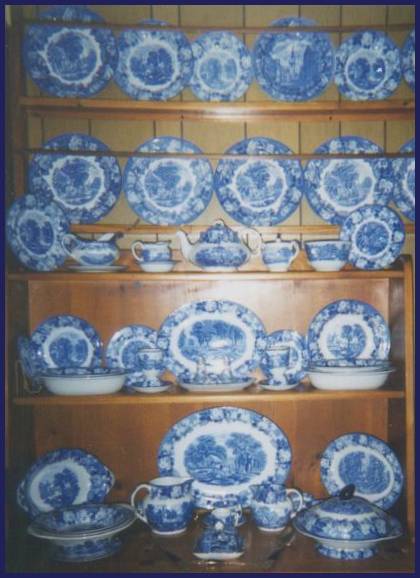
Enoch's son Moses , the
youngest of the three, continued the work , as did seven
generations of his offspring after him.
Enoch lived to be 83 and died in 1840. The Wood factory closed in
1846.
In 1865 a descendent of Moses, Absolom Wood, became the founder and senior partner in Wood & Son & Co. The site of the original factory was at Cobridge and was called Villa Pottery, but has since been demolished.
The line moved forward from Absolom with three of his sons. I'm still looking for information that will bring me up to the present. If and when I'm successful, I'll add any new information I find here.
![]()
About fifteen years ago, I did find one matching piece, a gravy boat, at the Gift shop in Old Sturbridge Village (Central Massachusetts). I was delighted to have finally found a piece. It meant I wasn't the only one left on Earth who knew or had the pattern! ;-)
In the Fall of 1996, shortly after I'd 'gone on-line', I was searching for information on the pattern when I discovered eBay. It was the only site that came up in an extensive search and indeed , someone did have a piece for sale there, but it was red and white, not blue and white. Two important discoveries in one day...English scenery was also made in red and white..and eBay!! What a fun site! <no..I didn't buy stock then :-( >
I checked back often but never saw anymore of the English Scenery pieces there. After several months of trying, I stopped.
Last July (1999), I went back to eBay and had another look. It had been almost two years since I had last tried. Imagine my delight when I saw several of the blue & white pieces there! I could hardly contain myself.
Needless to say, I've become a true-blue friend of ebay sellers. ;-)
I've managed to add many lovely and interesting pieces to my set, including a tea pot, a covered vegetable dish, a set of open salts/butter pats, two different sized pitchers and the best of all..the salt and peppers!
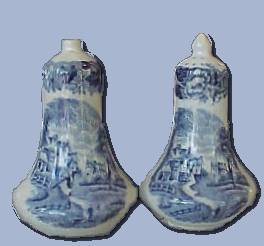
![]()
After receiving a few pieces, I was able to see some definite differences between technically the same pieces that were obviously made at different periods. For example :
![]()
Click on the
thumbnail below to see an enlarged picture. Use your browser's
back arrow to return here..
![]()
I received a very informative email from one of our site viewers, Beauville Antiques , who does know a bit about this pattern. You may want to check out his English Scenery pages at Beauville Antiques - WOODS English Scenery . Hoping he doesn't mind, I'd like to share some of the information he gave me :
"... over
the last couple of years I have done quite a lot of research into
the WOODS company, and I agree it is very frustrating - there is
a disappointing lack of information in the standard books.
However, I visited the Woods factory last summer (which still
exists in Stoke-on-Trent, Staffordshire) and was able to see some
of the surviving pattern books, etc, AND talk to some very
interesting and knowledgable people.
There seems to be widespread confusion about the age of the
ENGLISH SCENERY items that have the backstamp with the URN and
WOODSWARE and ENOCH WOODS ENGLISH SCENERY. This is made worse by
the dates 1750 and 1784 which appear left and right. Many people
assume incorrectly that these plates were manufactured by Enoch
Woods in the 1700s or 1800s.
Although E.W. did produce the first plates in this pattern in the
early to mid 1800s, they are now EXTREMELY scarce, and in any
case do not have a backstamp anything like the one described
above and illustrated on your website. I notice you don't mention
any dates, but I'm sure you are probably aware that the
"URN" backstamp was in use from approx 1917 onwards and
NO EARLIER. Unfortunately many people, including some who sell on
eBay, do not take the trouble to look this mark up in reference
books such as GODDEN, where you can see it on p689 (mark 4288). I
am trying to find out when the mark changed to the black one (#4
on your website).
Apparently Enoch Woods made 180 drawings for the ES pattern. When
designer Frederick Rhead took over as Art Director of the company
in 1912, he re-designed the border and re-drew some or all of the
scenes. He also designed the URN backstamp! The copper plates
from which the tranfers were taken would become worn in time and
would need to be re-engraved at intervals, which accounts for the
variations within the same design. Much of this information can
be found on the ES page on my own WEBSITE, which I hope you'll
have a look at . ...I spoke to one 86-old ex-Woods designer who
said the copper plates were so worn at one point that you could
no longer tell whether the animals were cows or sheep! He wanted
to redraw and re-engrave some of them but Woods' American agent
sent a telegram telling him on NO ACCOUNT to do so, Enoch Woods
designs were sacrosanct! This would have been around 1945-50..."
I'm so appreciative of this information, as I'm sure others who are here in a quest of any information on this pattern are as well. DO check out his site. He also gave me some information on the numbers stamped into the bottom of some of the plates. these numbers gave information of the month and year in which the piece was made. Unfortunately, I lost that email due to some email problems I was having. Perhaps he'll read this and be so kind as to give me the info again so I can share it here.
As a further note, I receive many emails from viewers wanting to know the value of their various pieces. Please, let me re stress what I wrote at the beginning of this page. I am NOT an expert and all the information I have managed to collect is found on this page. I have no other info for you and if it isn't here, I don't know the answer. I DID add a bullitin board here (see below) so that you might ask your questions or share your information with others interested in this pattern. Please, use it! Thanks.
Some Links to more information
Collecting Blue-Printed Pottery - Antique Dealer and Collectors Guide
Enoch Wood (& Sons) - Ceramic Trademarks
Encyclopędia Britannica -article on Wood & Sons
Encyclopędia Britannica -article on 18th century Pottery
Encyclopędia Britannica -article on Stoneware and earthenware
Enoch Wood, Burslem - a photo of the Enoch Wood factory in Burslem
![]()
More pieces will be added in the future. In addition, I plan to create several 'comparison' pages, where we can study the differences that are evident during the many different manufacturing decadessection for other sites . If any viewers have history of this pattern, or any information at all on it, please contact me at : LaPiers@msn.com .
Thanks! KathyL
>>>>To English Scenery
Comparison Page >>>>>
Copyright © LaPier Web Designs, 1999-2002
All rights reserved.
This page first created on January
12, 2000